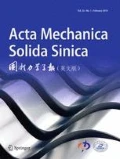Abstract
Naturally deposited or residual soils exhibit more complicated behavior than remolded clays. A dual-surface damage model for structured soils is developed based on the thermodynamics framework established in our first paper. The shift stresses and the transformation between the generalized dissipative stress space and actual stress space are established following a systematic procedure. The corresponding constitutive behavior of the proposed model is determined, which reflects the internal structural configuration and damage behavior for geomaterials. Four evolution variables k i j (i = D, R; j = V, S) and the basic parameters λ, s, v and e0 are introduced to account for the progressive loss of internal structure for natural clays. A series of fully triaxial tests and isotropic compression tests are performed for structured and reconstituted samples of Beijing and Zhengzhou natural clays. The validation of the proposed model is examined by comparing the numerical results with the experimental data.
Similar content being viewed by others
References
Burland, J.B., On the compressibility and shear strength of natural clays. Geotechinque, 1990, 40(3): 329–378.
Muir Wood, D., Soil Behavior and Critical State Soil Mechanics. New York: Cambridge University Press, 1990.
Martins, F.B., Bressani, L.A. and Coop, M.R. et. al., Some aspects of the compressibility behavior of a clayey sand. Canadian Geotechnical Journal, 2001, 38(6): 1177–1186.
Schofield, A.N. and Wroth, C.P., Critical State Soil Mechanics. London, UK: McGraw-Hill, 1968.
Krieg, R.D., A practical two-surface plasticity theory. Journal of Applied Mechanics, 1975, 42(3): 641–646.
Dafalias, Y.F., Bounding surface plasticity I: mathematical formulation and hypoplasticity. Journal of Engineering Mechanics, ASCE, 1986, 112(9): 966–987.
Manzari, M.T. and Dafalias, Y.F., A critical state two-surface plasticity model for sands. Geotechnique, 1997, 49(2): 252–272.
Luzzani, L. and Coop, M.R., On the relationship between particle breakage and the critical state of sands. Soils and Foundation, 2002, 42(2): 71–82.
McDowell, G.R. and Bolton, M.D., On the micro mechanics of crushable aggregates. Geotechnique, 1998, 48(5): 667–679.
Miura, N. and O-Hara, S., Particle crushing of a decomposed granite soil under shear stresses. Soils and Foundation, 1979, 19(3): 1–14.
Coop, M.R., Sorensen, K.K. and Bodas Freitas, T., Particle breakage during shearing of a carbonate sand. Geotechnique, 2004, 54(3): 157–163.
Been, K. and Jefferies, M.G., A state parameter for sands. Geotechnique, 1985, 35(2): 99–112.
Mitchell, J., Fundamentals of Soil Behaviour. New York: John Wiley and Sons Inc., 1976.
Lade, P.V. and Kim, M.K., Single hardening constitutive model for frictional materials — II. Yield criterion and plastic work contours. Computers and Geotechnics, 1988, 6: 13–29.
Lade, P.V. and Kim, M.K., Single hardening constitutive model for frictional materials — III. Comparisons with experimental data. Computers and Geotechnics, 1988, 6: 31–47.
Kavvadas, M. and Amorosi, A., A constitutive model for structured soils. Geotechnique, 2000, 50(3): 263–273.
Hardin, B.O., Crushing of soil particles. Journal of Geotechnical Engineering Division, ASCE, 1985, 111(10): 1177–1192.
Baudet, B. and Stallebrass, S., A constitutive model for structured clays. Geotechnique, 2004, 54(4): 269–278.
Chandler, H.W., Homogeneous and localized deformation in granular materials: a mechanistic model. International Journal of Engineering Science, 1990, 28(8): 719–734.
Kimoto, S. and Oka, F., A elasto-viscoplastic model for clay considering destructuralization and consolidation analysis of unstable behavior. Soils and Foundations, 2005, 45(2): 29–42.
Guo, X. and Zhao, C.G., Dual-surface damage model for natural clays within the thermomechanical framework (Part II). Proceeding of the International Workshop on Constitutive Modelling — Development, Implementation, Evaluation, and Application. Hong Kong, 2007, 516–522.
Ziegler, H., An Introduction to Thermomechanics (2nd edn). North Holland, Amsterdam, 1983.
Nakai, T. and Hinikio, M., A simple elastoplastic model or normally and over consolidated soils with unified material parameters. Soils and Foundation, 2004, 44(2): 53–70.
Author information
Authors and Affiliations
Corresponding author
Additional information
Project supported by the Major Research of the National Natural Science Foundation of China (No.90715035) and HI-Tech Research and Development Program of China (Code 2007AA11Z132).
Rights and permissions
About this article
Cite this article
Guo, X., Zhao, C., Yuan, D. et al. A dual-surface damage model and evaluation for natural soils within the thermomechanical framework. Acta Mech. Solida Sin. 21, 85–94 (2008). https://doi.org/10.1007/s10338-008-0811-8
Received:
Revised:
Published:
Issue Date:
DOI: https://doi.org/10.1007/s10338-008-0811-8




